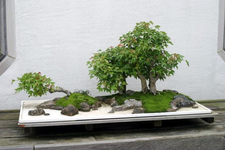randomatic
Seedling
- Messages
- 7
- Reaction score
- 4
- USDA Zone
- 6b
What do you use for Saikei soil in the us? Every demo and picture I see has what looks like black potting soil.
I’ve watched frank Goya’s two tutorials on YouTube, and he just says “rich” soil. I’ve read gustafson book, and he talks about filtering ground soil.
ive got typical bonsai soil ingredients of akadama, pumice, and lava. Definitely looks like bonsai soil and not what I saw in pictures and videos.
What would you recommend I use to get the same look of it being natural soil?
I’ve watched frank Goya’s two tutorials on YouTube, and he just says “rich” soil. I’ve read gustafson book, and he talks about filtering ground soil.
ive got typical bonsai soil ingredients of akadama, pumice, and lava. Definitely looks like bonsai soil and not what I saw in pictures and videos.
What would you recommend I use to get the same look of it being natural soil?


